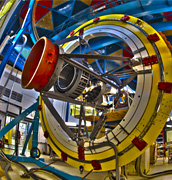



-
Dark Energy Camera records first light
Fermilab's 570-megapixel Dark Energy Camera, the product of eight years of planning and construction by scientists, engineers and technicians on three continents, has achieved first light. Mounted on the Blanco telescope in Chile, it will help unravel the universe’s most compelling mysteries.
-
Construction of NOvA neutrino detector
Technicians in Minnesota have begun to position the first block of the 14,000-ton NOvA neutrino detector. Check out the construction progress and watch our video about the mysterious behavior of neutrinos.
-
Voyage into the unknown
In the deep, dark quantum sea known as the Intensity Frontier, particle physicists expect to find everything from exotic new particles to new insights into the evolution of our universe.
-
Fermilab's Plan for the Future
Fermilab's plan for the future outlines a diverse, world-leading research program that addresses the most important—and most challenging—questions related to research at the Energy, Intensity and Cosmic Frontiers.
Fermilab Today
- Oct. 12, 2012
- From symmetry: Time projection chambers: a milestone in particle detector technology
- CMS Result: Hunting for the platypus particle
- From SLAC News Center: LCLS-II Project Director John Galayda to receive Wilson Prize
- Photo of the Day: Bird of an unrufflable feather
- From New Scientist, Oct. 4, 2012: Photon reaches from beyond the grave in quantum trick

- Feature:
Dark Energy Camera opens its eyes - Breaking:
Crews complete first block of NOvA experiment - Gallery:
SLAC at 50 - Breaking:
Summer school for African physics students - Breaking:
Read our most recent articles

The U.S. has contributed $531 million to the construction of the Large Hadron Collider and its particle detectors, located at CERN in Europe. From the LHC Remote Operations Center at Fermilab, U.S. scientists will monitor the collisions produced by the machine.

More than 900 scientists from the U.S. work on the CMS experiment at the LHC. Sifting through proton-proton collisions, scientists may find signs for dark matter particles, new subatomic forces and perhaps extra dimensions of space.
Featured
Second Fermilab muon experiment receives first-stage DOE approval

Fermilab's plans for creating a Muon Campus with top-notch Intensity Frontier experiments have received a big boost. The Department of Energy has granted Mission Need approval to the Muon g-2 project, one of two experiments proposed for the new Muon Campus.

Frontiers of Discovery
At Fermilab, scientists work on particle physics science and technology that leads to a better understanding of the physics of the universe and practical benefits to society.

Illinois Accelerator Research Center
At the Illinois Accelerator Research Center scientists and engineers will collaborate with industrial partners on breakthroughs in accelerator science and translate them into applications for the nation's health, wealth and security.

Building a Dark Energy Camera
Scientists wonder why the universe is expanding ever faster. What mysterious force is at work? By recording the light from hundreds of millions of galaxies, they hope to find out what's going on.

Long Baseline Neutrino Experiment
The proposed Long Baseline Neutrino Experiment will explore the transformations of the world's highest-intensity neutrino beam to find out what role neutrinos played in the evolution of the universe.

Project X
Project X would allow for numerous experiments at the intensity frontier and would allow scientists to develop technologies for a future machine at the energy frontier.

P5 report
The Particle Physics Project Prioritzation Panel proposes a strategic plan for the next 10 years to address the central questions in particle physics using a range of tools and techniques at three interrelated frontiers.
Beacons of Discovery
Beacons of Discovery outlines the unprecedented opportunities for scientific discovery available to particle physics and the potential rewards of the world’s nations and regions working together to form a single scientific enterprise.






